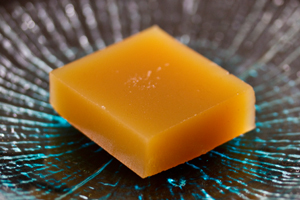How to Use Agar Agar
Agar agar is a gelling agent derived from seaweed & used in Japanese gelled desserts. It can be used to make vegetarian gels, hot gels, and liquid gels. Here’s how you use it.
INGREDIENTS
- Ingredients:
- Powdered Agar Agar
- Liquid to be Gelled* (demonstrated with apricot juice)
- Equipment:
- Kitchen Scale
- Gram Scale
- Small Pot
- Stove
- Whisk
- Container or Mold for Setting
- Optional:
- Blender (for liquid gels)
- Plastic Bag (for hot gels)
DIRECTIONS
1
This post assumes you already know the basics of how to use molecular gastronomy ingredients.
2
Weigh the liquid to be gelled & measure out the appropriate amount of agar agar.
Agar agar is typically used in concentrations ranging from 0.5% to 2%. How much you use depends on the application – the more you add, the firmer the resulting gel will be.
3
Heat the liquid in the pot on the stove, and whisk in the agar agar until dissolved.
4
Bring the liquid to a simmer for at least 5 minutes, stirring.
5
Pour the mixture into container or mold and let it cool until it sets (around 95˚F-110˚F).
Alternatively, you can let the mixture cool until just warm, then move it to the fridge to set more quickly.
6a
Serve cold or at room temperature OR
6b
Blend the gel in a blender until it becomes a thick liquid gel OR
6c
Put the gel in a zip top bag with all the air pressed out, or vacuum pack it and heat it in hot (but not boiling) water or a sous vide machine to your preferred temperature (anywhere below about 185˚F) before serving.
If the agar gets too hot and melts, let it cool until it re-sets (likely in the shape of the bag…you can avoid this by pouring it back into your mold).
*Note on Choosing Liquids:
Tannic acid (found in some wines, beers, juices (check ingredients), etc) can inhibit agar’s ability to gel. If your liquid contains it, be aware that you may need to adjust your recipe/have a backup plan.
Tannic acid (found in some wines, beers, juices (check ingredients), etc) can inhibit agar’s ability to gel. If your liquid contains it, be aware that you may need to adjust your recipe/have a backup plan.
Browse More:
Molecular Gastronomy Recipes & Techniques
Molecular Gastronomy Recipes & Techniques


